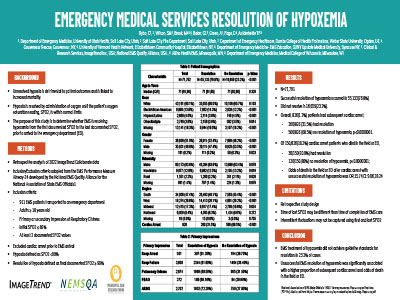ABSTRACTS
Emergency Medical Services Resolution of HypoxemiaAuthor: Christopher Ryba, Spencer M. Wilson, Melissa Brook, Garrett L. Baker, Alyssa M. Green, David Page, and Tom P. Aufderheide | | Associate Authors:
Objective: To evaluate emergency medical services (EMS) resolution of hypoxemia. Methods: Retrospective review of the national ImageTrend Collaborate database from January 1, 2022, to December 31, 2022. Inclusion criteria were as follows: 9-1-1 EMS patients transported to an emergency department (ED), adults (≥ 18 years), a primary or secondary impression of respiratory distress, an initial SpO2 ≤ 89%, and at least two documented SpO2 values. Cardiac arrest prior to EMS arrival was excluded. The first and last SpO2 values were compared to determine resolution of hypoxemia based on the Airway Measure Guidelines by the National Association of EMS State Officials, defined as an SpO2 ≥ 90%. Results: Of the 5,095,330 adult patients, 71,792 met the inclusion criteria. Median age was 71.0 (IQR = 61–80) years; 36,600 (51.0%) were female; race distribution was Black 9,890 (13.8%), Hispanic/Latino 2,860 (4.0%), White 43,161(60.1%), Other 2,740 (3.8%), and Missing Data 13,141 (18.3%). Successful resolution of hypoxemia occurred in 55,133 (76.8%) and did not resolve in 16,659 (23.2%). Overall, 826 (1.2%) patients had subsequent cardiac arrest; 260 (31.5%) of these patients had resolution of hypoxemia and 566 (68.5%) did not (p < .0000001). Of the 150 (18.2%) cardiac arrest patients who died in the field or ED, 30 (20.0%) had resolution of hypoxemia and 120 (80%) did not (p < .0000001). Odds of death in the field or ED after cardiac arrest with unsuccessful resolution of hypoxemia was 15.74 (95% CI = 9.06–28.24). Conclusion: EMS treatment of hypoxemia did not achieve guideline standards for resolution in 23.2% of cases. Unsuccessful EMS resolution of hypoxemia was significantly associated with a higher proportion of subsequent cardiac arrest and odds of death in the field or ED.
|

